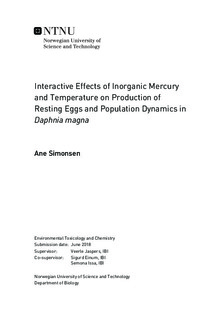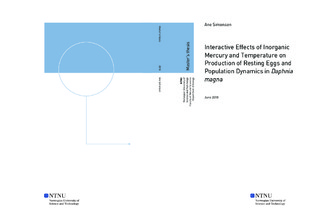| dc.description.abstract | Freshwater ecosystems are particularly vulnerable to the effects of climate change. In addition to the predicted increase in global surface temperatures, expected change in patterns of precipitation and wind can significantly alter the structure and functioning of these ecosystems. The predicted changes in climate variables can also influence the properties of toxic chemicals. Of particular concern is the reported enhanced toxicity of various metals, including mercury, at elevated temperatures. Considering that atmospheric mercury concentrations have increased threefold since preindustrial times, knowledge about the combined effects of these two stressors are important to properly manage ecosystem and human health in the future.
The present study investigated the interactive effects of elevated temperature and inorganic mercury toxicity using Daphnia magna as a model organism, a key species in freshwater ecosystems with widespread use in toxicity studies. Daphnia are facultative parthenogenetic, reproducing clonally during favorable conditions, but switching to sexual reproduction with resting egg production when conditions deteriorate. Although knowledge about effects of environmental stressors on both clonal and sexual reproduction seem essential to assess population effects, studies typically only asses the former mode. Thus, population growth experiments were run with a duration of nine weeks, allowing for the animals to grow past their carrying capacity and commence sexual reproduction. A factorial design was used, with two temperatures and three environmentally relevant concentrations (including control) of mercuric chloride (HgCl2). Populations were monitored at weekly intervals using video recordings and tracking software to record population size (number of individuals), total biomass, and the number of resting eggs produced.
A significantly lower population size, as well as maximum and final biomass, was observed at 24°C than at 17°C. An explanation for this might be faster manifestation of resource scarcity related to increased metabolic costs at higher temperatures. As expected, limiting resources at 24°C promoted higher resting egg production compared to 17°C in the present study. Albeit displaying a less prominent effect than that of temperature, HgCl2 treatment increased resting egg production by the daphnids and decreased maximum biomass. No clear conclusion on the interaction of the two parameters can be drawn based on the current study, although an indication of interactive effects was observed on total number of resting eggs produced. The underlying causes for this observation are not obvious. More research is therefore needed to confirm the results. | |

